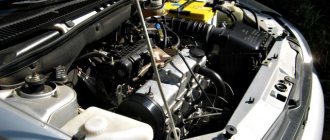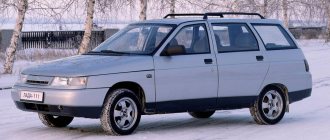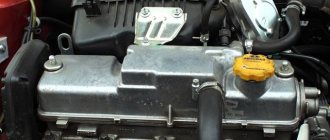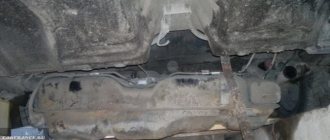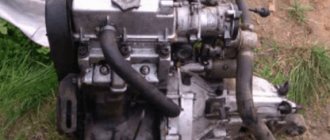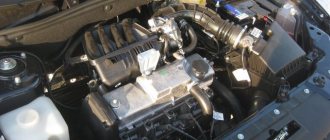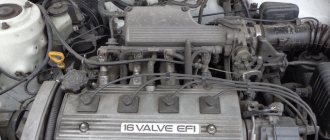Engine VAZ 11183-50
The 183-50 engine was installed on the first Kalina; it was one of the first internal combustion engines with an injector. A huge advantage of this engine is that it does not bend the valve if the timing belt breaks. The engine is equipped with 8 valves, which affects the noise of its operation, as well as a fairly frequent procedure for adjusting the valve clearance.
Specifications
Advantages and disadvantages
Pros:
- No bending of the valves when the belt breaks;
Minuses:
- Need for valve adjustment
- Low engine power;
- Outdated components;
- Noisy operation;
Technical Standards and Troubleshooting
All power units of the Lada Kalina are installed together with a 5-speed manual transmission. For the 8-valve Kalina engine, an oil change is provided after 15,000 km. The timing belt, according to technical documentation, should be replaced every 60,000 km. But in order not to run the risk of replacing the belt in the field, it is recommended to change it every 50,000 miles.
In general, chronic deficiencies do not need to be eliminated, but, as with any mechanism, breakdowns are inevitable. As practice shows, any part can fail. From the cylinder head to the offset of the liners. The 16-valve Kalina engine often has problems with the gearbox. Its technical capabilities reach zero after a mileage of about 100,000 km.
When passing the 25-30 thousand km mark, special attention should be paid to the clutch disc. More than 60% of owners replace it during this period. If your family budget allows it, then it is best to install an imported analogue. In 95% of cases, it will last much longer than its original VAZ.
If the Lada Kalina was purchased secondhand, then it is necessary to check the entire engine compartment. It is necessary to make sure that the compression is uniform in all cylinders in the Kalina engine. Otherwise, the protection of the power unit may be at risk. The steering rack should also be checked. This is Kalina’s weak point; such a “chronic disease” is inherent in cars produced before 2006.
One of the signals to seriously think about repairs (possibly overhaul) in the Kalina engine is the exponentially increasing oil consumption. This can happen either at 40 or 140 thousand km. More than half a liter of oil per 1000 km is a critical signal.
Be prepared that the cost of repairs may approach 20,000 rubles. The main elements that require replacement and repair may be: the piston camshaft (the clearance may already be critical), the cylinder block (boring will be required). Changing the engine oil yourself will help you save a lot of money. To do this you need to complete 6 steps.
- We warm up the engine to operating temperature, soot and sludge will be better washed out.
- We put the car on the handbrake and determine where the drain plug points.
- Drain the engine oil and replace the oil filter.
- Install a new filter.
- Pour in new oil and check the level.
- We make a test drive and check the level again.
Engine VAZ 11186
This engine replaced the 11183 internal combustion engine. Distinctive features of this engine are a lightweight cylinder-piston group and connecting rods. Also in the engine, the compression ratio was increased by reducing the recesses for the valves, therefore, this led to bending of the valves when the timing belt breaks.
Specifications
Advantages and disadvantages
Pros:
- Increased compression ratio;
- More modern components;
Minuses:
- Noisy operation;
- Bend valves when the belt breaks;
- The need to adjust the valves;
Description of main faults
On Kalina, with regard to power units, there are a number of constant malfunctions. Why are they considered permanent? Most likely, this is due to design flaws that the designers cannot correct. So, let's look at which faults are more common than others.
The engine gets hot
The cause of this phenomenon is often the thermostat. As everyone knows, this is a common occurrence on cars produced by AvtoVAZ, starting with the “Classics”. To eliminate the problem, you need to replace the thermostat with a new one. But what to do if the reason is not in it, and the engine was heating up for another reason? It is worth determining why this is so and what the reasons are.
- Temperature sensor malfunction.
- The cooling fan has failed.
- Faulty wiring or electronic engine control unit.
Failure to comply with the temperature regime can lead to engine malfunction, and will also lead to significant malfunctions of the cylinder head and cylinder block. It is worth remembering that the recommended operating temperature of the Kalina engine is 87-103 degrees Celsius.
To ensure that the car does not heat up above the recommended values, it is necessary to check whether the cooling system and other related components are working properly.
Engine VAZ 21126
This engine is equipped with two camshafts and 16 valves. Compared to 8-valve engines, there is increased power and quieter operation of the internal combustion engine. The engine is equipped with hydraulic compensators that automatically adjust the valves, but often during a cold start they make a knocking noise that goes away as the engine warms up.
Specifications
Advantages and disadvantages
Pros:
- More dynamic characteristics;
- The torque is noticeably greater;
Minuses:
- Bend valves when belt breaks
- Demanding on the quality of oil;
- Knock of hydraulic compensators when cold;
Conclusion
The Lada Kalina engine has several options. Thus, numerous variants of power units were installed on vehicles, which were developed for other models produced by AvtoVAZ. The engine has a simple design and is quite easy to maintain and repair.
The choice of oil for the Kalina engine is a very sensitive issue, since it determines how long and efficiently the main unit of the car will work. Therefore, it is recommended to fill in the fluid recommended by the manufacturer.
Engine VAZ 21127
The most modern engine installed in serial Kalinas. The engine received a more modern intake receiver with modified geometry. This modification made it possible to increase the technical characteristics of the engine. The outdated mass air flow sensor was replaced by an absolute pressure sensor, which made it possible to forget about floating engine speeds forever.
Specifications
Advantages and disadvantages
Pros:
- High speed;
- Lack of mass air flow sensor;
Minuses:
- Bend valves when the timing belt breaks;
A new generation is replacing
In 2022, Russian roads welcomed the new Lada-Kalina 2 model. It immediately caught the fancy of those who were passionate about VAZ products, and began to win new fans. In terms of body models, Kalina 2 is currently limited to hatchback and station wagon.
They repeat their predecessors in height 1500 mm, ground clearance 210 mm, wheelbase 2476 mm and track: rear 1414 mm / front 1431 mm.
Other dimensions are not the same. Body control dimensions show:
- “hatchback” - length 3893 mm and width 1700 mm;
- “station wagon” - 4084 mm and 1539 mm;
- The trunk volume is the same - 260/361 liters.
Nothing in the world is perfect, there will always be critics and detractors. Nevertheless, even a cursory glance at what ordinary users write, sharing their impressions without the goal of advertising anyone, confirms: “Lada-Kalina 2” is a good city car. If we add to the above such important parameters as “price - quality” and “gasoline consumption in the city”, then it can be considered one of the leaders in its market segment.
The same opinion can be heard in any “garage fraternity”, where they express themselves artlessly, but with knowledge of the matter. Popular approval has been received, as has the expectation of new models.
New Lada: Repair and operation manual for Lada Kalina, VAZ-11183, VAZ-11184.
Engine Kalina Sport
Kalina Sport received a VAZ 21126-77 engine. This engine is highly boosted with increased power and torque. From the attachments on the engine, the intake receiver and direct-flow muffler have changed. A camshaft with modified cams made it possible to change the valve timing.
ICE characteristics
Advantages and disadvantages
Pros:
- High speed;
- Powerful engine;
Minuses:
- Bend valves when the belt breaks;
- Small resource;
- High fuel consumption;
Dimensions value
The Kalina family is small but friendly. Some are a little bigger, some are a little smaller, but together they can make it to the parade. The body of the Lada Kalina is made in several modern modifications: sedan, hatchback, station wagon, cross and sport. Their overall dimensions do not vary much.
| Sedan | Hatchback | Station wagon | Cross | Sport | |
| Length, mm | 4040 | 3850 | 4040 | 4104 | 3943 |
| Width, mm | 1700 | 1700 | 1700 | 1700 | 1700 |
| Height | 1500 | 1500 | 1500 | 1560 | 1450 |
| Weight | 1098 | 1098 | 1128 | 1125 | 1150 |
| Base | 2476 | 2476 | 2476 | 2476 | 2476 |
| Clearance | 160 | 160 | 145-160 | 183 | 150 |
The width and wheelbase are the same for all, as it should be for related models. But the length, height and ground clearance are different. Accordingly, the volumes and masses are different. The history of Lada models has seen long stagnation and a period of failure. In 2004, the release of the first Kalina from the assembly line ushered in a new era. Since then, new items appear almost every season, and the ranks of owners of the most popular car in Russia are growing from year to year.
The geometric dimensions of the body are important, but no less interesting is the volume of the trunk. All Kalina models are designed to allow the rear seats to be folded forward and increase luggage compartment space. The most voluminous trunks are for the sedan, station wagon and cross: 355/670 liters. “Hatchback” and “sport” are more modest - 240/550 hp. It’s also not bad, as many city car owners will agree with.
In the ranks of Kalina there is another model - Lada Kalina City (Oka-3), made on the VAZ-1117 platform. It appeared in 2005 and for some time was considered a replacement for the Oka small car, but this assumption is incorrect. It has almost the same dimensions, height and width as other Kalinas, only the length is 3650 mm.
There is another dimensional indicator that is rarely interested in until they get stuck in a rut. At this point, some people discover the fact that the distance between the front wheels is different from the distance between the rear. This parameter is called: front and rear wheel track. For the “sedan” and “hatchback” with “station wagon” - 1430/1414 mm, for the “sport” - 1431/1432 mm and for the “cross” - 1430/1418 mm.
New Lada: Lada Kalina 1 and 2 tank volume: how many liters
The difference in millimeters may not be noticeable to the eye, but it is easy to feel when a few millimeters are not enough to get out of an icy rut on a winter road. The track size turned out to be wrong.
Kalina NFR engine
Kalina with the NFR prefix is equipped with the most powerful engine installed in the Lada, VAZ 21126-81. The NFR has the same engine as the sport modification, but more powerful. Sports camshafts, intake and exhaust manifolds gave the engine more agility and playfulness.
ICE characteristics
Advantages and disadvantages
Pros:
- High speed;
- High torque;
- Powerful engine;
Minuses:
- Bend valves when the belt breaks;
- Small resource;
- High fuel consumption;
Powertrain tuning
Tuning the Lada Kalina engine is carried out by analogy with other power units produced by AvtoVAZ. So, the first thing motorists do is chip tuning. Software settings that allow you to either increase power or reduce consumption. There is also an option to make a balance between two important indicators.
The second option is to overhaul the engine itself and bore it. The power unit is equipped with a lightweight piston group, as well as other tuning parts. Typically, as practice shows, motorists change elements of the cooling and air supply systems.
It is recommended to carry out tuning of the Lada Kalina engine in special studios and services, where professionals can do everything and configure it correctly.
Exterior
The appearance of the second generation Lada Kalina remained recognizable, but received a more harmonious, attractive and modern finish. The nose of the car is decorated with a hood with characteristic ribs, and there are also stylish lighting equipment with a darkened background and a massive front bumper with an air intake “mouth” and chrome decor (top trim levels also have fog lights).
The head optics flow smoothly into the narrow strip of the radiator grille. The bumper installed in front is of a relief type with a massive air intake in the center and has fog lights along the edge, which are covered with chrome “eyelashes”. True, we must admit that an air intake of this size does not fit perfectly with the overall design of the Lada Kalina 2.
Thanks to the smoothed body corners, the aerodynamic component has been improved, which has made it possible to reduce the noise of headwinds and make travel at high speeds more comfortable. If you look at the side of the car, you can see the presence of a sloping hood, a slightly sloping roof towards the rear, large door openings and large wheel arches.
All this together allows the hatchback to have a light and moderately dynamic silhouette. The fact that there are no stampings on the side body parts is made up for by the presence of door trims, which give the appearance of the car some relief against the background of the overall smoothing of the appearance. The wheel arches turned out to be a little swollen, and thanks to the high ground clearance of the hatchback, its solidity is felt.
The rear of the Lada Kalina 2 is compact and has beautiful lights, a neat luggage compartment lid and a small bumper with a plastic cover at the bottom, which serves as a protective option. As a result, the domestic new product looks quite good and fresh, and in terms of design it matches foreign cars.
